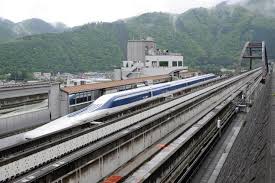“Its not a bird…its not a plane… its NOT Superman for sure…its the fastest train on Earth at your service.”
I believe that is how the Japanese will market their latest product – a Maglev train with a world-record shattering top speed of 603 km/hr. After decades of research, engineers at Yamanashi, Japan successfully tested the train earlier this week. The train spent 10.8 seconds travelling above 600 km/hr during which it covered 1.8 km. Maglev train is being planned to run from Tokyo to Nagoya and Osaka. The whole line is estimated to be completed by 2045 at a cost of $76 billion while the line between Tokyo and Nagoya will be completed by 2027.
Many people know about high-speed bullet trains but would know little about its technology – Maglev. Maglev is short for magnetic levitation. Literary speaking, this technology allow trains to ‘float’ over a guideway track using electromagnets and the principle of magnets – attraction and repulsion. Unlike conventional trains, Maglev trains do not run on fossil fuels nor they have an engine to propel it.
Inside a Maglev track there are a large number of electric coils. When induced with electric power, these coils get electro-magnetised. Now, there is a set of magnets attached on the train’s undercarriage. Electricity is passed through the underground coils such that its magnetic pole is same as that in train’s undercarriage, leading to a repulsion when the train is above the track. This allows the train to levitate or hover in the air eliminating friction completely.
Once it is done, current is supplied in a way to constantly and quickly change their polarity. This causes a magnetic field behind the train to push it forward while those in front help in pulling it., thus moving the train. Without friction a Maglev train reach very high speeds and the recent development is a proof of that. Bullet trains are globally produced in Japan, China, Germany and France.
It is reported that Japan is trying to sell this high-speed train technology to US. According to experts this train is good in developing countries and not in developed countries, for example US where air travel is more cheap and prominent, and Japan itself whose population is decreasing and find little takers for such trains. This can lead to losses for investors.
Actually it is a desperate attempt to revive the Japanese economy. By selling this technology to US, Japan is hoping to make profits. But the strategy may backfire. The technology’s construction costs are high and the demand is very limited. Moreover, the proposed Tokyo-Nagoya Line is being built underground, creating higher risk of earthquakes in an already quake-prone area. Also, these trains make lot of noises and vibrations which will put pressure on the fragile land.
Personally, I think that once operational, the Japan’s Maglev would get slower and reach a top speed between 450 – 550 km/hr. Moreover, I hope to see India producing bullet trains by 2027.





14 Comments. Leave new
Nice article…really informative! I think if this works out then Japan can revive its economy through infrastructure to a great extent.
Thanks for commenting on the article. I agree with you. Japan’s infrastructure and technology have helped them come out of lot of problems in the past and this time too, it won’t be any different.
So detailed post! And I’m glad that india has also started investing in this kind of technology. This is all due to the man of action, Mr. Modi.
Well I don’t know for sure whether India has invested or not, but I hope we will in future.
Another feather in Japan’s cap!
Nice concept…!
nicely written after good research 🙂
Keep it up 🙂
Thanks Nitesh.
You detailed every single point! We always try to be more faster and faster! This technology is the result of human desire to be faster!
Good work 🙂
Thanks
Informative 🙂
Useful info.
Very well explained 😀
The topic is all well chosen , reseacrhed and applied 😀
Good work 😀
Thanks Anirudh. Thanks for appreciating and commenting.